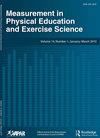7项社交体质焦虑量表的测量不变性
IF 1.9
4区 教育学
Q2 EDUCATION & EDUCATIONAL RESEARCH
Measurement in Physical Education and Exercise Science
Pub Date : 2023-02-05
DOI:10.1080/1091367X.2023.2173527
引用次数: 1
摘要
社交体质焦虑是运动科学研究中常见的一项研究,旨在了解个体的身体活动动机和行为。虽然存在12项和9项版本的社会体质焦虑量表,但7项版本已成为测量这种结构的流行工具,尽管需要进一步研究其测量特性。本研究考察了7项量表的因子结构及其在年龄、性别、体质指数、典型运动方式、文化程度等方面的测量不变性。与过去的工作类似,验证性因子分析模型需要修改,以达到足够的拟合在我们的大样本体力活动的男性和女性(N = 1009;年龄= 28.6±10.6岁)。多组潜在分析显示,只有教育水平分组变量具有测量不变性。研究人员在进行主要分析之前,应先检验并报告7项量表的测量模型和测量不变性。本文章由计算机程序翻译,如有差异,请以英文原文为准。
Testing Measurement Invariance of the 7-item Social Physique Anxiety Scale
ABSTRACT Social physique anxiety is commonly examined in exercise science to understand individuals’ physical activity motivation and behavior. Although a 12-item and 9-item version of the Social Physique Anxiety Scale exists, a 7-item version has become a popular tool to measure this construct despite the need to further examine its measurement properties. The current study examined the factor structure of the 7-item scale and measurement invariance across age, gender, body mass index, typical exercise mode, and education level. Similar to past work, confirmatory factor analysis model modifications were needed to achieve adequate fit in our large sample of physically active men and women (N = 1009; M age = 28.6 ± 10.6 years). Multi-group latent analysis revealed measurement invariance only for the education level grouping variable. Researchers should examine and report the measurement model of the 7-item scale along with measurement invariance before proceeding with main analyses.
求助全文
通过发布文献求助,成功后即可免费获取论文全文。
去求助
来源期刊

Measurement in Physical Education and Exercise Science
Medicine-Orthopedics and Sports Medicine
CiteScore
4.20
自引率
33.30%
发文量
24
期刊介绍:
The scope of Measurement in Physical Education and Exercise Science (MPEES) covers original measurement research, special issues, and tutorials within six substantive disciplines of physical education and exercise science. Six of the seven sections of MPEES define the substantive disciplines within the purview of the original research to be published in the journal: Exercise Science, Physical Activity, Physical Education Pedagogy, Psychology, Research Methodology and Statistics, and Sport Management and Administration. The seventh section of MPEES, Tutorial and Teacher’s Toolbox, serves to provide an outlet for review and/or didactic manuscripts to be published in the journal. Special issues provide an avenue for a coherent set of manuscripts (e.g., four to five) to collectively focus in-depth on an important and timely measurement-related issue within the scope of MPEES. The primary aim of MPEES is to publish high-impact manuscripts, most of which will focus on original research, that fit within the scope of the journal.
 求助内容:
求助内容: 应助结果提醒方式:
应助结果提醒方式:


